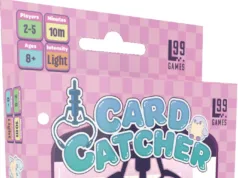 In the quiet town of Ravenswood Bluff, a drunk walks amongst you. Also, a demon and their minions. A blood-curdling shriek is heard in the distance. By the time you arrive, all you find are the slain bodies of a Werewolf, a Mafia, and a Resistance. Is this just a terrible nightmare or has Blood on the Clocktower triumphed in the world of social deduction games?
In the quiet town of Ravenswood Bluff, a drunk walks amongst you. Also, a demon and their minions. A blood-curdling shriek is heard in the distance. By the time you arrive, all you find are the slain bodies of a Werewolf, a Mafia, and a Resistance. Is this just a terrible nightmare or has Blood on the Clocktower triumphed in the world of social deduction games?
Blood on the Clocktower is a social deduction game for 5 to 20 players, which works best somewhere in the median range.
Gameplay Overview:
In Blood on the Clocktower, all players are provided a random secret role. The available roles are determined by the edition (scenario) chosen and the number of players. All players will have special roles that fall into one of four categories. Townsfolk and Outsiders make up the good team, while Minions and Demons make up the evil team. The goal for Townsfolk and Outsiders is to find and execute the demon. The goal for the Minions and Demon is to destroy the town, leaving only the demon and one other player alive.
The game is played in rounds split into two phases: day and night. During the day phase players will talk to each other to try to gather information or attempt to fool other players with misinformation. During the night phase, many special abilities activate, and nominations and votes are cast to determine if a player will be executed. Finally, the demon player will kill one other player before the night ends.
Play continues in this cycle until one team reaches its goal. Throughout the game, most players will die, but continue to participate fully and still have one remaining vote to use in the game.
The game is managed by a storyteller who will be the main source of new information entering the game. If a player’s role gives a player information, that information will come from the storyteller. However, there are game effects that can alter the accuracy of the information a player receives. If a player is drunk, they think they have a special role/power, but in reality, the storyteller can give them false information. If a player is poisoned, their ability no longer works and the storyteller can give them false information. It is the job of the storyteller to create a well-balanced game that keeps both teams engaged. Their goal is to keep everyone engaged and entertained, hence the name, storyteller.

Game Experience:
If you’ve played a social deduction game like Werewolf, Mafia, or The Resistance, then this concept may not sound super original. To be honest, it’s not. Blood on the Clocktower does, however, add quite a bit to those games. There’s a wide variety of character roles, various scenarios, an evolving influx of information, no player elimination, and statuses like drunk or poisoned that gum up the works.
Let’s talk about those extra layers. Instead of almost everyone having the same role (generic good person, generic bad person, etc…), every single player has a unique role and power to go along with it. There are 72 different roles available across the 3 editions in the base game.

In other games of this ilk, I’m often bummed out if I’m not one of the special roles. This game works around that. Additionally, the variety of roles ensures that every game will feel totally different. Just having a couple of different roles in a game creates totally new interactions.
The deductive puzzle created from the variety of roles and interactions is fascinating. Cue Charlie Kelly in the mailroom trying to find Pepe Sylvia. Players will get new pieces of information every day and night. With the few allies you think you can trust, you start to piece together what could be going on. Then maybe someone uses their ability to get some new information that completely disproves previous theories. What you don’t know is if that player is telling the truth or maybe just drunk/poisoned. Suspicions will continuously rise all the way until the end, and that creates an evolving level of tension.
Figuring out who you can trust is crucial. In a single game, you’ll form some pretty tight alliances and lean on others for information. There’s a strong chance that you’ll have your trust betrayed at some point unless you’re too busy betraying someone else’s trust. All you know for sure is what role you are and whatever information you gleaned using your special ability. That is, of course, unless you are drunk or poisoned. Those statuses mean you may be getting false information from the storyteller.

With the right group, Blood on the Clocktower is incredibly engrossing. Everyone is engaged in solving the puzzle. You’ll form some deep bonds even with people you didn’t know before the game. It would be a real challenge to just sit on the sideline, scrolling through your phone because there’s so much sleuthing to do and new information is constantly entering the system, even if some of it is not true. The thing you’re pretty well guaranteed to get out of this game is a conversation about what went down right after the game and a fun story to tell for a long time after.
Like many of the games I love, this game is very fragile. You’ll need a large group of engaged players and a skilled storyteller for this to really shine. Because it’s so interactive and social, the experience can be soured if one person checks out, gets aggressive, or makes a lot of mistakes. Ideally, all players are of a similar experience level, although a really good storyteller can work around that. At its peak, this game can be magical and create stories that I’d compare to an exciting RPG session.
Finally, the player count is important here. It is not at its best with fewer than 10. On the flip side, playing with 15 or more players creates an epic experience, but runs a bit longer than it should, especially if you have a talkative group. You’re looking at over 3+ hours, which is tough to justify for a social deduction game.
Final Thoughts:
This game attempts to refine and elevate the experience you get in something like Werewolf. I feel like they succeeded in that goal. What you have here is one of those classic games with extra layers and interweaving elements. What you don’t have is a totally new experience that will win over social deduction haters. When all of the pieces fall into place (right players, right edition, right storyteller), it’s an experience that I’d recommend to most. This one is a great convention experience. It will create some lasting memories and hopefully some strong bonds.
Final Score: 4 Stars – An elevated and epic social deduction experience with the right people.
 Hits:
Hits:
• Wide variety of interesting roles means no one is a vanilla villager
• The game and the tension continuously evolve until the very end
• No player elimination
• Creates some great stories and memories
Misses:
• Very fragile, requires the right players and a skilled storyteller
• Player count is not as flexible as the box may lead you to believe
• Won’t win over any social deduction haters






















